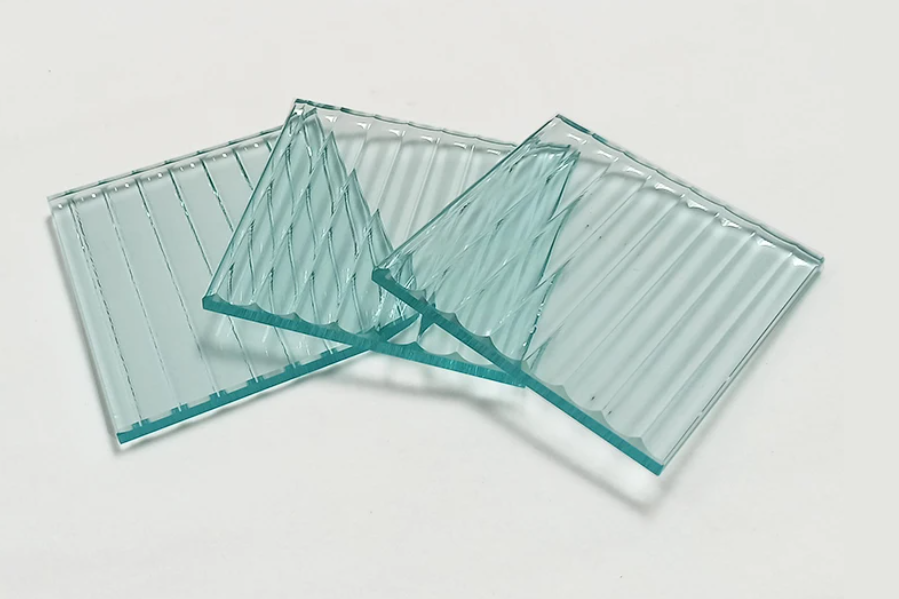
Elegance and Versatility: The Beauty of Fluted Glass
Fluted glass, known for its distinctive ribbed or grooved texture, stands as a remarkable architectural element that combines elegance, functionality, and privacy in various applications. This unique glass type, featuring linear indentations on its surface, offers a multitude of uses and benefits in the realm of interior and exterior design.
Fluted glass, with its characteristic vertical ridges, infuses spaces with a sense of sophistication and visual intrigue. The texture plays with light, creating captivating visual effects that enhance the ambiance of any environment. Its ability to diffuse light while maintaining privacy makes it a favored choice for both residential and commercial settings.

Processing Techniques:
Rolling or Casting: Fluted glass is typically manufactured using the rolling or casting method. In the rolling process, molten glass passes through rollers with a specific pattern, imprinting the desired ribbed texture onto the glass surface. Alternatively, in the casting method, the molten glass is poured into molds featuring the fluted pattern, and once cooled, the glass takes on the pattern of the mold.
Moulding and Pressing: In the moulding process, the glass is pressed into molds with the desired ribbed pattern. This method allows for precise control over the depth, width, and spacing of the flutes.
Annealing: After the glass is formed with the fluted texture, it undergoes an annealing process. Annealing involves controlled heating and cooling to relieve internal stresses within the glass, ensuring its structural integrity and durability.
Cutting and Finishing: Once the glass is formed and annealed, it goes through cutting and finishing processes. Skilled artisans carefully cut the glass into desired shapes and sizes, refining the edges for smoothness and safety.
Quality Control: Throughout the processing stages, stringent quality control measures are employed to ensure the final product meets industry standards for clarity, uniformity, and strength. Any imperfections or defects are meticulously addressed during this phase.

Applications:
Interior Partitions and Doors: Fluted glass partitions redefine spaces by offering a balance between openness and privacy. They are extensively used in office spaces, providing visual separation without compromising on natural light transmission.
Cabinet Doors and Shelving: In interior design, fluted glass cabinet doors and shelves add a touch of elegance to kitchens, bathrooms, or any area requiring storage. These elements allow diffused light to illuminate the interiors while discreetly concealing contents.
Furniture Accents: Incorporating fluted glass in furniture pieces, such as tabletops or decorative accent panels, infuses a modern and sophisticated touch to interiors.
Exterior Facades: Fluted glass finds applications in exterior facades, creating a striking visual appeal while maintaining privacy. It’s often used in commercial buildings, offering a distinctive architectural aesthetic.
Light Fixtures: As an element in light fixtures or lampshades, fluted glass adds a unique play of light, creating beautiful patterns and enhancing the overall ambiance.
Benefits:
Privacy with Natural Light: Fluted glass maintains privacy by diffusing direct views while allowing natural light to permeate interiors, reducing the need for artificial lighting.
Aesthetic Appeal: The unique texture of fluted glass adds depth and character to spaces, enhancing their visual appeal.

Versatility: Its versatility in design applications makes it an ideal choice for both modern and classic architectural styles.
Acoustic Properties: In some cases, fluted glass offers sound insulation benefits, providing a degree of acoustic privacy in spaces.
Ease of Maintenance: Like other glass types, fluted glass is easy to clean and maintain, making it a practical choice for various environments.
Fluted glass stands as an epitome of versatility, offering an artistic blend of style, functionality, and privacy. Its ability to transform spaces while maintaining a harmonious balance between openness and seclusion makes it an exceptional choice for contemporary architectural designs.





